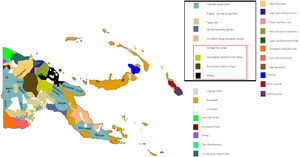
Back পাপুয়া নিউগিনির ভাষা Bengali/Bangla Llengües de Papua Nova Guinea Catalan Jazyky Papuy Nové Guineje Czech Sprachen Papua-Neuguineas German Γλώσσες της Παπούα Νέας Γουινέας Greek زبانهای پاپوآ گینه نو Persian Luettelo Papua-Uuden-Guinean kielistä Finnish Langues en Papouasie-Nouvelle-Guinée French Jezici Papue Nove Gvineje Croatian Dagiti pagsasao ti Papua Baro a Guinea ILO
| Languages of Papua New Guinea | |
|---|---|
 | |
| Official | Tok Pisin, English, Hiri Motu, Papua New Guinean Sign Language |
| Indigenous | Papuan languages |
| Vernacular | Hiri Motu (in the New Guinea Highlands), Tok Pisin (nationwide) |
| Immigrant | Chinese |
| Foreign | French,[1][2] Indonesian,[2] Japanese,[3] Russian[4] |
Papua New Guinea, a sovereign state in Oceania, is the most linguistically diverse country in the world.[5] According to Ethnologue, there are 840 living languages spoken in the country.[6] In 2006, Papua New Guinea Prime Minister Sir Michael Somare stated that "Papua New Guinea has 832 living languages (languages, not dialects)."[7][8]
Most of these are classified as indigenous Papuan languages, which form a diverse sprachbund across the island of New Guinea. There are also many Austronesian languages spoken in Papua New Guinea, most of which are classified as Western Oceanic languages, as well as some Admiralty Islands languages and Polynesian Ellicean–Outlier languages in a few outer islands. Since the late 19th century, West Germanic languages — namely English and German — have also been spoken and adapted into creoles such as Tok Pisin, Torres Strait Creole and Unserdeutsch.
Languages with statutory recognition are Tok Pisin, English, Hiri Motu, and Papua New Guinean Sign Language.[9][10] Tok Pisin, an English-based creole, is the most widely spoken, serving as the country's lingua franca. Papua New Guinean Sign Language became the fourth officially recognised language in May 2015, and is used by the deaf population throughout the country.
- ^ "PNG University promotes French language".
- ^ a b "The French Language Celebrated in Papua New Guinea | Coopération Régionale et Relations Extérieures de la Nouvelle-Calédonie".
- ^ "Launching of Japanese Language Proficiency Test".
- ^ "Papua New Guineans embrace Russian exchange". Radio New Zealand. 17 October 2019.
- ^ Krishnan, Varun B. (7 August 2019). "Which Country Has Most Number of Languages? Not India". The Hindu. Retrieved 14 February 2022.
- ^ "Languages of Papua New Guinea". Ethnologue. 21 February 2017.
- ^ Somare, Michael T. (21 September 2006). Statement at the World Leaders Forum (Speech). World Leaders Forum. Columbia University, New York. Archived from the original on 18 March 2008 – via Office of the Prime Minister of Papua New Guinea.
- ^ "Papua New Guinea's Incredible Linguistic Diversity". The Economist. 24 July 2017. Retrieved 20 July 2017.
- ^ There is no specific legislation proclaiming official languages in Papua New Guinea. In the constitution of Papua New Guinea, section 2(11) (literacy) of its preamble mentions '...all persons and governmental bodies to endeavour to achieve universal literacy in Pisin, Hiri Motu or English' as well as "tok ples" and "ita eda tano gado". In addition, section 67 (2)(c) mentions "speak and understand Pisin or Hiri Motu, or a vernacular of the country, sufficiently for normal conversational purposes" as a requirement for citizenship by nationalisation; this is again mentioned in section 68(2)(h).
- ^ Silva, Diego B. (2019). "Política Linguística Na Oceania: Nas Fronteiras da Colonização e da Globalização". Alfa: Revista de Linguística. 63 (2): 317–347. doi:10.1590/1981-5794-1909-4. S2CID 204627919.